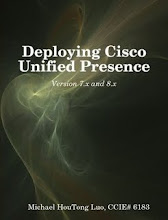Before you continue, be aware that this procedure is NOT approved by Cisco. Neither Cisco nor I will be responsible for any loss caused by this.
Any bootable disc has to follow "El Torito" specification. No exception for Cisco discs. The only difference between a bootable disc and non-bootable disc is the "boot sector". Thus the solution is very simple - extract the boot sector from a bootable disc and inject it into a non-bootable disc.
The boot sector is a very small file (usually less than 10k). And the boot sector is usually content independent (i.e. you may extract the boot sector from CUCM 7.1.3 and inject it into 7.1.5). You may save the boot sector on your USB thumb drive and keep it handy.
To extract/inject the boot sector, you need some disc image tools like UltraISO. (You may also use other ISO tools with similar features)
Step 1: Get the boot file
There are two ways to get a boot file - extract from the DVD's file system (regardless bootable or not) or extract from a bootable DVD's boot sector.
Option 1: Extract from DVD's file system (regardless bootable or not)
This option is preferred as you don't have to find another bootable disc or ISO file.
The boot file should be available on any CUCM DVD, regardless bootable or not. It is located in the "isolinux" folder. File name is isolinux.bin.
Extract and save the isolinux.bin file to your hard drive. We'll need to use that later.
Option 2: Extract the boot sector from a bootable DVD
If for some reason, you were not able to find/extract the isolinux.bin file, you may extract the boot file from a bootable disc (or ISO image).
Put a bootable CUCM disc into the DVD drive and launch UltraISO. Go to menu "Bootable > Extract Boot File from CD/DVD..."

Save the file to your hard drive as a "boot info file" (bif). In our example, we call it "boot.bif"

Step 2: Inject the boot file
Open the non-bootable image in UltraISO. Go to menu "Bootable". Make sure "Generate Bootinfotable" was checked (it will NOT work without this option). Then choose "Load Boot File...".

Choose the boot file we saved before (isolinux.bin or boot.bif).

Note that the image type changed to "Bootable".
 Now, you may go to "File > Save As" to save the bootable image to an ISO file. Then you may burn the ISO to a disc with your favorite disc burner software.
Now, you may go to "File > Save As" to save the bootable image to an ISO file. Then you may burn the ISO to a disc with your favorite disc burner software.


This is just great!!!
ReplyDeleteHi Michael
ReplyDeleteKeep receiving the message: Image Checksum error..
And the DVD does not boot
Any ideas?
Thanks
Solved
ReplyDeleteI'm doing with CUCM 6.1(5), I did the same with your procedure, the disk successfully boots but there's an error "Hardware Detection Fail". When I press OK, it says "Please insert an USB storage key to continue"
ReplyDeleteCan you try with version 6.1(5)?
Thank you,
I think somebody hijacked your post. check this link
ReplyDeletewww.harshil.in/cisco/cisco-voice/make-a-non-bootable-iso-image-to-bootable-iso/
I'm flattered. I was told "imitation is the highest form of compliment". :)
ReplyDeletei made a stick bootable with UltraISO, but now i want it back at its normla state. i need those 8 GB back. i dont know how to do it.
ReplyDeleteThank you very much. It works like a champ! I installed CUPS 8.5.2 with ISO downloaded from Cisco website (which is non bootable) by injecting a boot sector taken from a CUPS 7.0.4 DVD.
ReplyDeleteAlejandro,
ReplyDeleteHow did you solve the 'Image checksum error'?
Hi:
ReplyDeleteHow did you fix the "Image Checksum error.." ?
Already solved, i wasn't checking the "Generate Bootinfotable", my bad.
ReplyDeletethanks...
please tell me how you fix this error?
ReplyDelete"Image Checksum error.."
Just read one post above you (dated Jul 3, 2011). :)
ReplyDeletei just recieve could not find kernel image :liunx
ReplyDeleteTo fix "Image Checksum error" you need to setup the option Generate Bootinfotable and rewrite the image.
ReplyDeleteI had what error too and successfully fix it.
Thanks everyone.
Do you know of any tools like UltraISO for Mac OS X?
ReplyDeleteHi, My name is Leandro and i writing from Argentina. Thank You Very Much for this tuto. :)!!!
ReplyDeleteThanks guys,
ReplyDeleteSadly I dont have a bootable disc to copy the file from, could anybody help?
Thanks
Craig.
Hey Craig,
DeleteLook at this: http://angryciscoguy.com/jello/category/cucm/
This way you create your own bootfile.
good luck,
Joost
Works perfecly for me, thanks.
ReplyDeleteI wanted to say a big thanks. This has helped many a times.
ReplyDeleteHave you tried this with Mac OS X? I've found articles on how to do this (not specific to Cisco UC images), but they have not worked.
ReplyDeleteDear, am lokking for cucm 7.0.2.20000-5 ios file, can anyone help on this
ReplyDeleteThanks Brother ,,,
ReplyDelete